Unilever's Global Logistics and Supply Chain Management: A Case Study
VerifiedAdded on 2023/06/11
|17
|4679
|431
Case Study
AI Summary
This case study provides an in-depth analysis of Unilever's global logistics and supply chain management strategies. It explores how Unilever organizes its factories and supply chains regionally, addressing challenges and ensuring customer satisfaction. The report discusses the implementation of lean and agile strategies within Unilever's logistics operations, highlighting the company's pioneering role in lean management. It also identifies key issues and challenges faced by Unilever, offering recommendations for improvement. The analysis covers Unilever's supply chain process, from raw material sourcing to product distribution, and examines the company's commitment to corporate social responsibility and sustainable practices. This document is available on Desklib, where students can find a wealth of solved assignments and study resources.
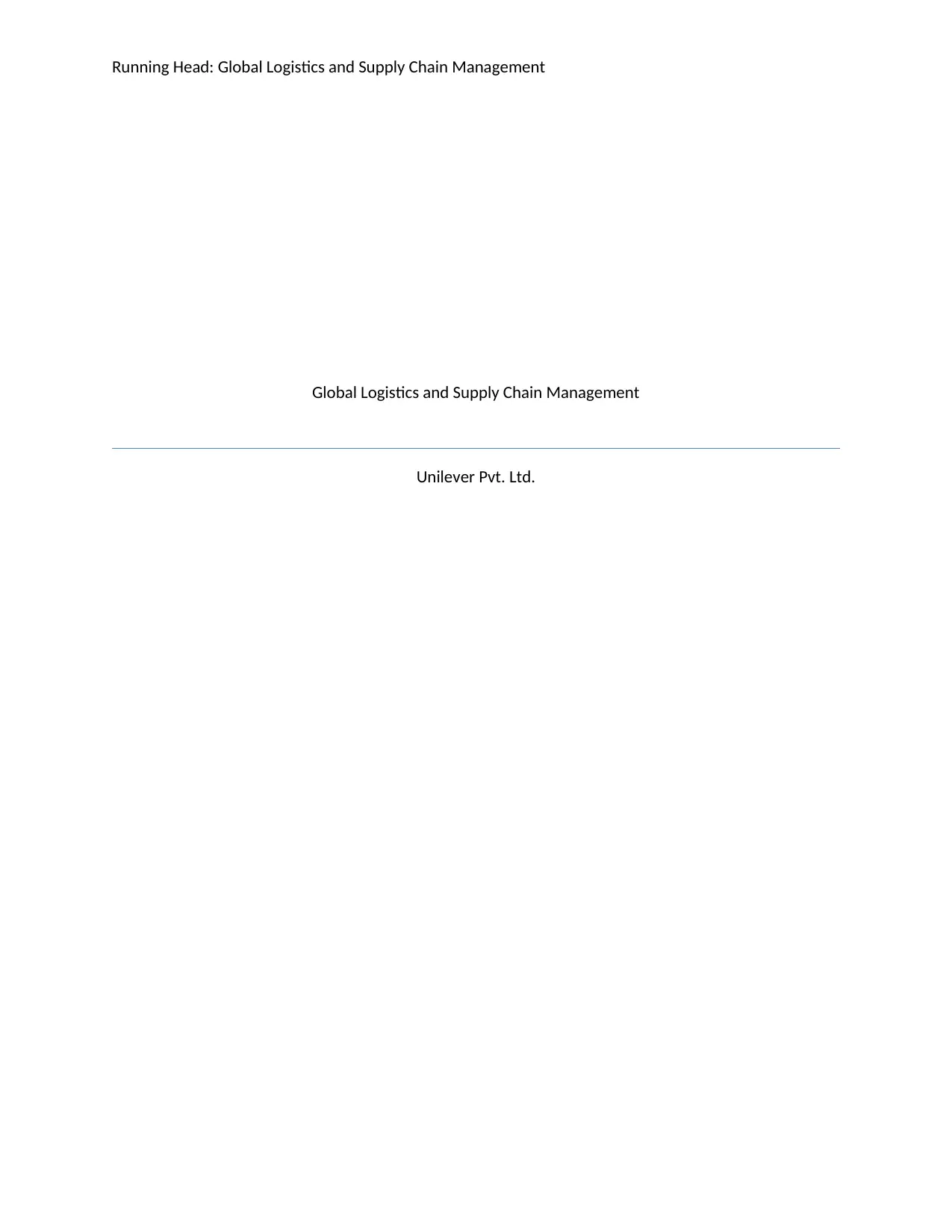
Running Head: Global Logistics and Supply Chain Management
Global Logistics and Supply Chain Management
Unilever Pvt. Ltd.
Global Logistics and Supply Chain Management
Unilever Pvt. Ltd.
Paraphrase This Document
Need a fresh take? Get an instant paraphrase of this document with our AI Paraphraser
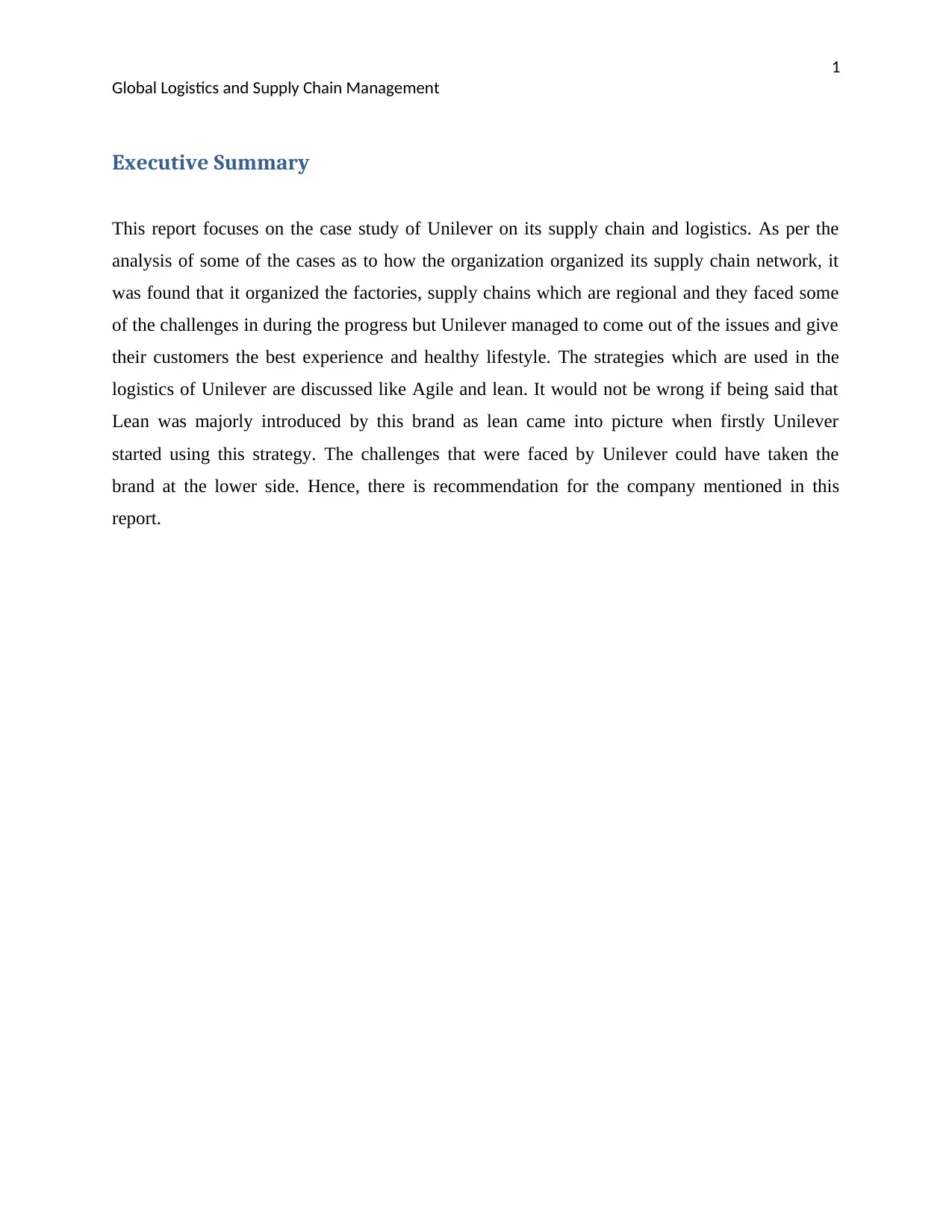
1
Global Logistics and Supply Chain Management
Executive Summary
This report focuses on the case study of Unilever on its supply chain and logistics. As per the
analysis of some of the cases as to how the organization organized its supply chain network, it
was found that it organized the factories, supply chains which are regional and they faced some
of the challenges in during the progress but Unilever managed to come out of the issues and give
their customers the best experience and healthy lifestyle. The strategies which are used in the
logistics of Unilever are discussed like Agile and lean. It would not be wrong if being said that
Lean was majorly introduced by this brand as lean came into picture when firstly Unilever
started using this strategy. The challenges that were faced by Unilever could have taken the
brand at the lower side. Hence, there is recommendation for the company mentioned in this
report.
Global Logistics and Supply Chain Management
Executive Summary
This report focuses on the case study of Unilever on its supply chain and logistics. As per the
analysis of some of the cases as to how the organization organized its supply chain network, it
was found that it organized the factories, supply chains which are regional and they faced some
of the challenges in during the progress but Unilever managed to come out of the issues and give
their customers the best experience and healthy lifestyle. The strategies which are used in the
logistics of Unilever are discussed like Agile and lean. It would not be wrong if being said that
Lean was majorly introduced by this brand as lean came into picture when firstly Unilever
started using this strategy. The challenges that were faced by Unilever could have taken the
brand at the lower side. Hence, there is recommendation for the company mentioned in this
report.
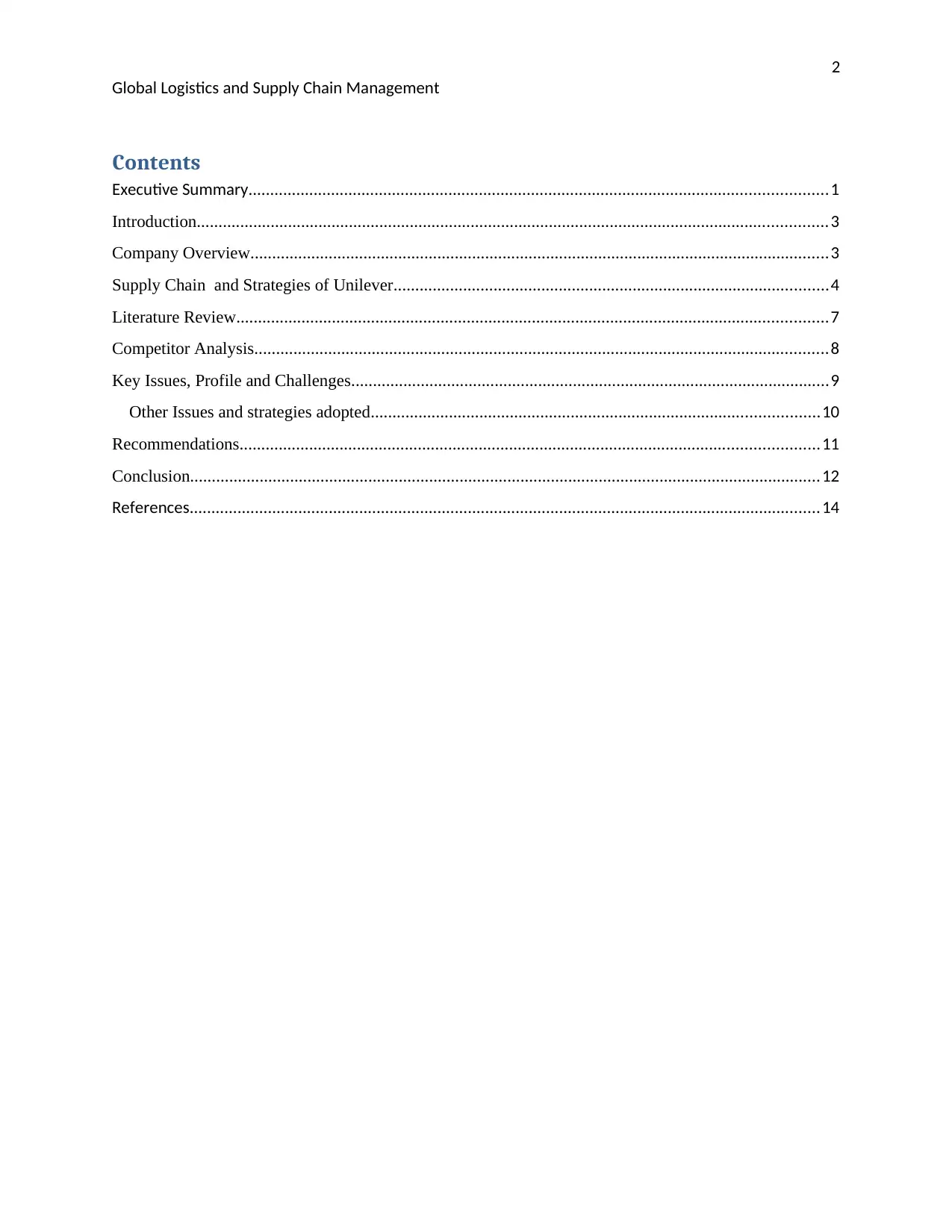
2
Global Logistics and Supply Chain Management
Contents
Executive Summary.....................................................................................................................................1
Introduction.................................................................................................................................................3
Company Overview.....................................................................................................................................3
Supply Chain and Strategies of Unilever....................................................................................................4
Literature Review........................................................................................................................................7
Competitor Analysis....................................................................................................................................8
Key Issues, Profile and Challenges..............................................................................................................9
Other Issues and strategies adopted.......................................................................................................10
Recommendations.....................................................................................................................................11
Conclusion.................................................................................................................................................12
References.................................................................................................................................................14
Global Logistics and Supply Chain Management
Contents
Executive Summary.....................................................................................................................................1
Introduction.................................................................................................................................................3
Company Overview.....................................................................................................................................3
Supply Chain and Strategies of Unilever....................................................................................................4
Literature Review........................................................................................................................................7
Competitor Analysis....................................................................................................................................8
Key Issues, Profile and Challenges..............................................................................................................9
Other Issues and strategies adopted.......................................................................................................10
Recommendations.....................................................................................................................................11
Conclusion.................................................................................................................................................12
References.................................................................................................................................................14
⊘ This is a preview!⊘
Do you want full access?
Subscribe today to unlock all pages.

Trusted by 1+ million students worldwide
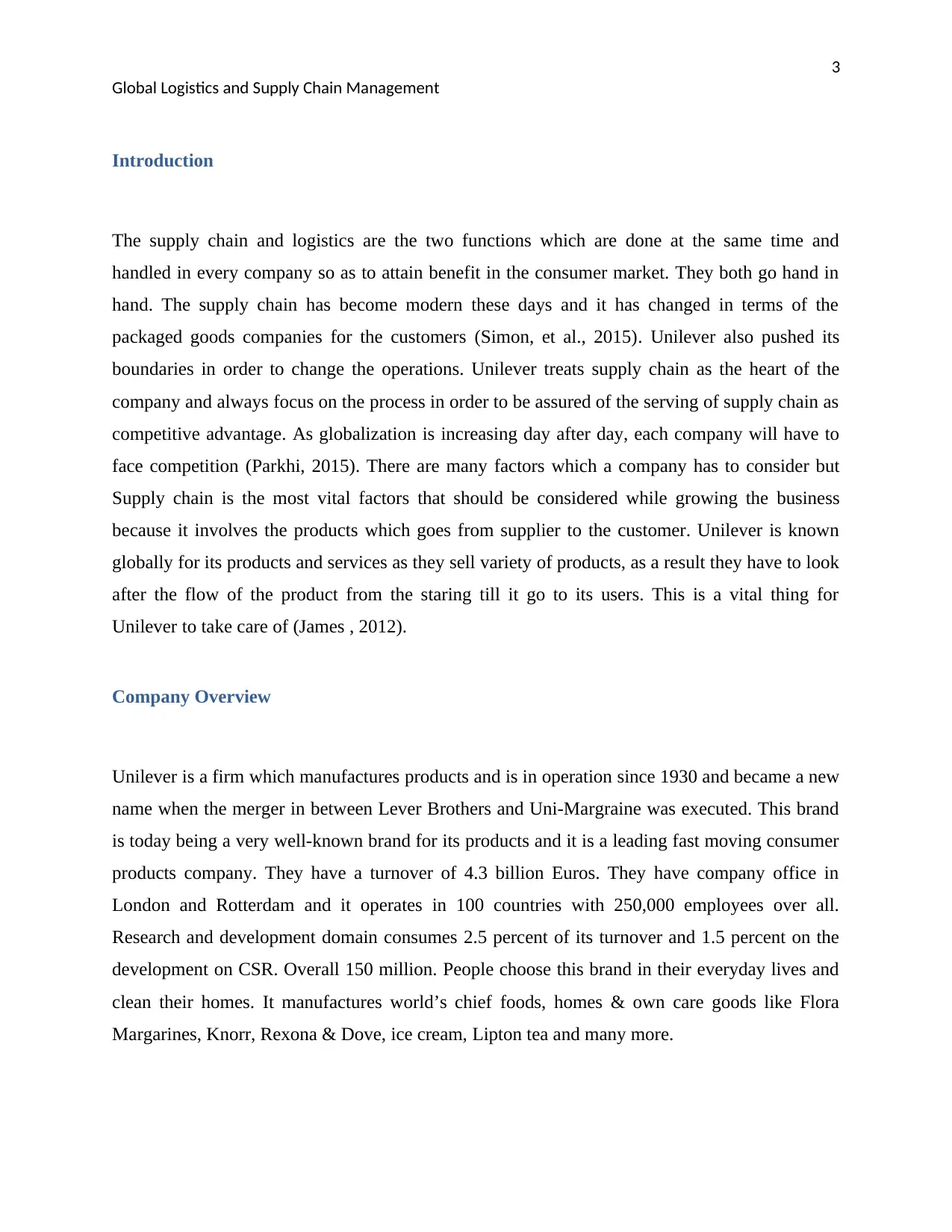
3
Global Logistics and Supply Chain Management
Introduction
The supply chain and logistics are the two functions which are done at the same time and
handled in every company so as to attain benefit in the consumer market. They both go hand in
hand. The supply chain has become modern these days and it has changed in terms of the
packaged goods companies for the customers (Simon, et al., 2015). Unilever also pushed its
boundaries in order to change the operations. Unilever treats supply chain as the heart of the
company and always focus on the process in order to be assured of the serving of supply chain as
competitive advantage. As globalization is increasing day after day, each company will have to
face competition (Parkhi, 2015). There are many factors which a company has to consider but
Supply chain is the most vital factors that should be considered while growing the business
because it involves the products which goes from supplier to the customer. Unilever is known
globally for its products and services as they sell variety of products, as a result they have to look
after the flow of the product from the staring till it go to its users. This is a vital thing for
Unilever to take care of (James , 2012).
Company Overview
Unilever is a firm which manufactures products and is in operation since 1930 and became a new
name when the merger in between Lever Brothers and Uni-Margraine was executed. This brand
is today being a very well-known brand for its products and it is a leading fast moving consumer
products company. They have a turnover of 4.3 billion Euros. They have company office in
London and Rotterdam and it operates in 100 countries with 250,000 employees over all.
Research and development domain consumes 2.5 percent of its turnover and 1.5 percent on the
development on CSR. Overall 150 million. People choose this brand in their everyday lives and
clean their homes. It manufactures world’s chief foods, homes & own care goods like Flora
Margarines, Knorr, Rexona & Dove, ice cream, Lipton tea and many more.
Global Logistics and Supply Chain Management
Introduction
The supply chain and logistics are the two functions which are done at the same time and
handled in every company so as to attain benefit in the consumer market. They both go hand in
hand. The supply chain has become modern these days and it has changed in terms of the
packaged goods companies for the customers (Simon, et al., 2015). Unilever also pushed its
boundaries in order to change the operations. Unilever treats supply chain as the heart of the
company and always focus on the process in order to be assured of the serving of supply chain as
competitive advantage. As globalization is increasing day after day, each company will have to
face competition (Parkhi, 2015). There are many factors which a company has to consider but
Supply chain is the most vital factors that should be considered while growing the business
because it involves the products which goes from supplier to the customer. Unilever is known
globally for its products and services as they sell variety of products, as a result they have to look
after the flow of the product from the staring till it go to its users. This is a vital thing for
Unilever to take care of (James , 2012).
Company Overview
Unilever is a firm which manufactures products and is in operation since 1930 and became a new
name when the merger in between Lever Brothers and Uni-Margraine was executed. This brand
is today being a very well-known brand for its products and it is a leading fast moving consumer
products company. They have a turnover of 4.3 billion Euros. They have company office in
London and Rotterdam and it operates in 100 countries with 250,000 employees over all.
Research and development domain consumes 2.5 percent of its turnover and 1.5 percent on the
development on CSR. Overall 150 million. People choose this brand in their everyday lives and
clean their homes. It manufactures world’s chief foods, homes & own care goods like Flora
Margarines, Knorr, Rexona & Dove, ice cream, Lipton tea and many more.
Paraphrase This Document
Need a fresh take? Get an instant paraphrase of this document with our AI Paraphraser
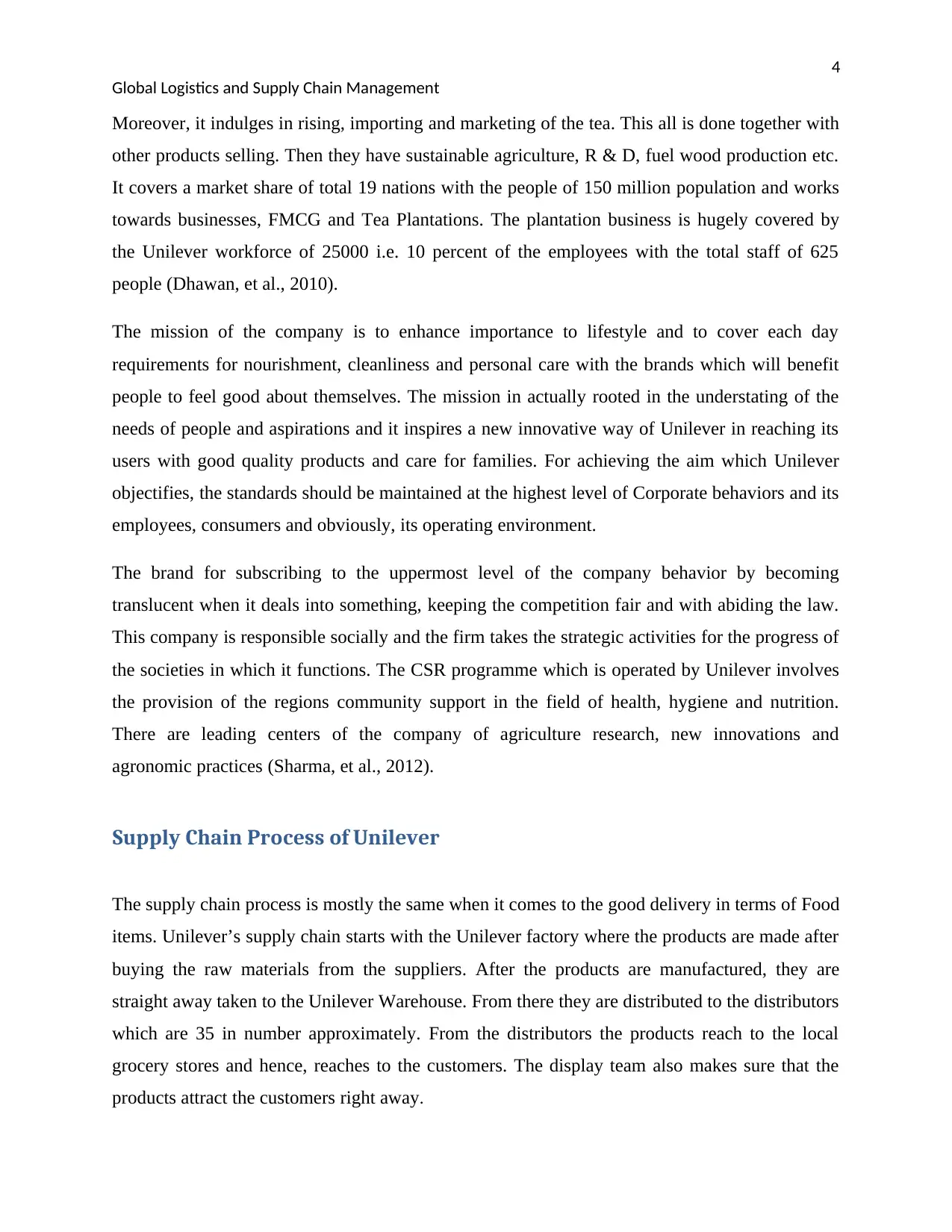
4
Global Logistics and Supply Chain Management
Moreover, it indulges in rising, importing and marketing of the tea. This all is done together with
other products selling. Then they have sustainable agriculture, R & D, fuel wood production etc.
It covers a market share of total 19 nations with the people of 150 million population and works
towards businesses, FMCG and Tea Plantations. The plantation business is hugely covered by
the Unilever workforce of 25000 i.e. 10 percent of the employees with the total staff of 625
people (Dhawan, et al., 2010).
The mission of the company is to enhance importance to lifestyle and to cover each day
requirements for nourishment, cleanliness and personal care with the brands which will benefit
people to feel good about themselves. The mission in actually rooted in the understating of the
needs of people and aspirations and it inspires a new innovative way of Unilever in reaching its
users with good quality products and care for families. For achieving the aim which Unilever
objectifies, the standards should be maintained at the highest level of Corporate behaviors and its
employees, consumers and obviously, its operating environment.
The brand for subscribing to the uppermost level of the company behavior by becoming
translucent when it deals into something, keeping the competition fair and with abiding the law.
This company is responsible socially and the firm takes the strategic activities for the progress of
the societies in which it functions. The CSR programme which is operated by Unilever involves
the provision of the regions community support in the field of health, hygiene and nutrition.
There are leading centers of the company of agriculture research, new innovations and
agronomic practices (Sharma, et al., 2012).
Supply Chain Process of Unilever
The supply chain process is mostly the same when it comes to the good delivery in terms of Food
items. Unilever’s supply chain starts with the Unilever factory where the products are made after
buying the raw materials from the suppliers. After the products are manufactured, they are
straight away taken to the Unilever Warehouse. From there they are distributed to the distributors
which are 35 in number approximately. From the distributors the products reach to the local
grocery stores and hence, reaches to the customers. The display team also makes sure that the
products attract the customers right away.
Global Logistics and Supply Chain Management
Moreover, it indulges in rising, importing and marketing of the tea. This all is done together with
other products selling. Then they have sustainable agriculture, R & D, fuel wood production etc.
It covers a market share of total 19 nations with the people of 150 million population and works
towards businesses, FMCG and Tea Plantations. The plantation business is hugely covered by
the Unilever workforce of 25000 i.e. 10 percent of the employees with the total staff of 625
people (Dhawan, et al., 2010).
The mission of the company is to enhance importance to lifestyle and to cover each day
requirements for nourishment, cleanliness and personal care with the brands which will benefit
people to feel good about themselves. The mission in actually rooted in the understating of the
needs of people and aspirations and it inspires a new innovative way of Unilever in reaching its
users with good quality products and care for families. For achieving the aim which Unilever
objectifies, the standards should be maintained at the highest level of Corporate behaviors and its
employees, consumers and obviously, its operating environment.
The brand for subscribing to the uppermost level of the company behavior by becoming
translucent when it deals into something, keeping the competition fair and with abiding the law.
This company is responsible socially and the firm takes the strategic activities for the progress of
the societies in which it functions. The CSR programme which is operated by Unilever involves
the provision of the regions community support in the field of health, hygiene and nutrition.
There are leading centers of the company of agriculture research, new innovations and
agronomic practices (Sharma, et al., 2012).
Supply Chain Process of Unilever
The supply chain process is mostly the same when it comes to the good delivery in terms of Food
items. Unilever’s supply chain starts with the Unilever factory where the products are made after
buying the raw materials from the suppliers. After the products are manufactured, they are
straight away taken to the Unilever Warehouse. From there they are distributed to the distributors
which are 35 in number approximately. From the distributors the products reach to the local
grocery stores and hence, reaches to the customers. The display team also makes sure that the
products attract the customers right away.
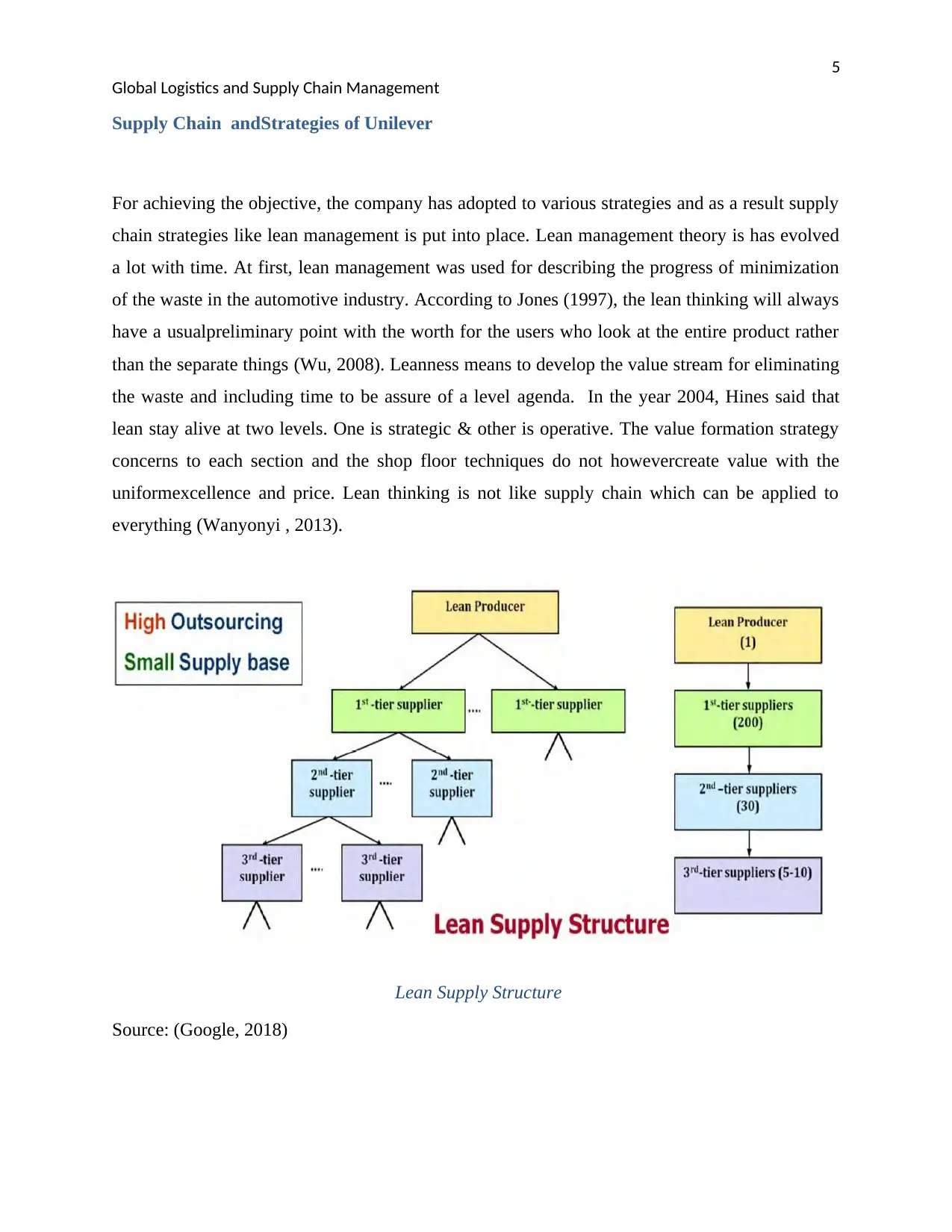
5
Global Logistics and Supply Chain Management
Supply Chain andStrategies of Unilever
For achieving the objective, the company has adopted to various strategies and as a result supply
chain strategies like lean management is put into place. Lean management theory is has evolved
a lot with time. At first, lean management was used for describing the progress of minimization
of the waste in the automotive industry. According to Jones (1997), the lean thinking will always
have a usualpreliminary point with the worth for the users who look at the entire product rather
than the separate things (Wu, 2008). Leanness means to develop the value stream for eliminating
the waste and including time to be assure of a level agenda. In the year 2004, Hines said that
lean stay alive at two levels. One is strategic & other is operative. The value formation strategy
concerns to each section and the shop floor techniques do not howevercreate value with the
uniformexcellence and price. Lean thinking is not like supply chain which can be applied to
everything (Wanyonyi , 2013).
Lean Supply Structure
Source: (Google, 2018)
Global Logistics and Supply Chain Management
Supply Chain andStrategies of Unilever
For achieving the objective, the company has adopted to various strategies and as a result supply
chain strategies like lean management is put into place. Lean management theory is has evolved
a lot with time. At first, lean management was used for describing the progress of minimization
of the waste in the automotive industry. According to Jones (1997), the lean thinking will always
have a usualpreliminary point with the worth for the users who look at the entire product rather
than the separate things (Wu, 2008). Leanness means to develop the value stream for eliminating
the waste and including time to be assure of a level agenda. In the year 2004, Hines said that
lean stay alive at two levels. One is strategic & other is operative. The value formation strategy
concerns to each section and the shop floor techniques do not howevercreate value with the
uniformexcellence and price. Lean thinking is not like supply chain which can be applied to
everything (Wanyonyi , 2013).
Lean Supply Structure
Source: (Google, 2018)
⊘ This is a preview!⊘
Do you want full access?
Subscribe today to unlock all pages.

Trusted by 1+ million students worldwide
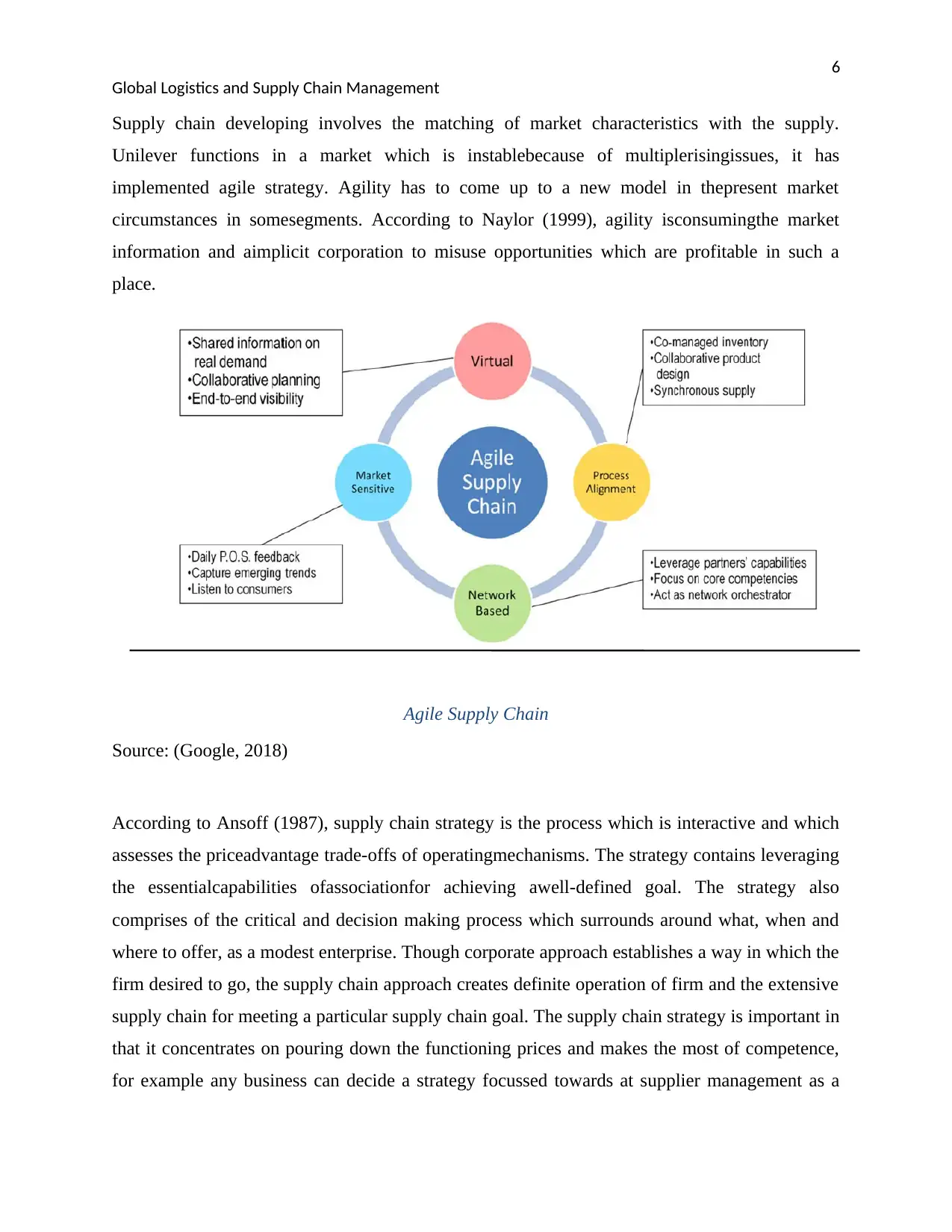
6
Global Logistics and Supply Chain Management
Supply chain developing involves the matching of market characteristics with the supply.
Unilever functions in a market which is instablebecause of multiplerisingissues, it has
implemented agile strategy. Agility has to come up to a new model in thepresent market
circumstances in somesegments. According to Naylor (1999), agility isconsumingthe market
information and aimplicit corporation to misuse opportunities which are profitable in such a
place.
Agile Supply Chain
Source: (Google, 2018)
According to Ansoff (1987), supply chain strategy is the process which is interactive and which
assesses the priceadvantage trade-offs of operatingmechanisms. The strategy contains leveraging
the essentialcapabilities ofassociationfor achieving awell-defined goal. The strategy also
comprises of the critical and decision making process which surrounds around what, when and
where to offer, as a modest enterprise. Though corporate approach establishes a way in which the
firm desired to go, the supply chain approach creates definite operation of firm and the extensive
supply chain for meeting a particular supply chain goal. The supply chain strategy is important in
that it concentrates on pouring down the functioning prices and makes the most of competence,
for example any business can decide a strategy focussed towards at supplier management as a
Global Logistics and Supply Chain Management
Supply chain developing involves the matching of market characteristics with the supply.
Unilever functions in a market which is instablebecause of multiplerisingissues, it has
implemented agile strategy. Agility has to come up to a new model in thepresent market
circumstances in somesegments. According to Naylor (1999), agility isconsumingthe market
information and aimplicit corporation to misuse opportunities which are profitable in such a
place.
Agile Supply Chain
Source: (Google, 2018)
According to Ansoff (1987), supply chain strategy is the process which is interactive and which
assesses the priceadvantage trade-offs of operatingmechanisms. The strategy contains leveraging
the essentialcapabilities ofassociationfor achieving awell-defined goal. The strategy also
comprises of the critical and decision making process which surrounds around what, when and
where to offer, as a modest enterprise. Though corporate approach establishes a way in which the
firm desired to go, the supply chain approach creates definite operation of firm and the extensive
supply chain for meeting a particular supply chain goal. The supply chain strategy is important in
that it concentrates on pouring down the functioning prices and makes the most of competence,
for example any business can decide a strategy focussed towards at supplier management as a
Paraphrase This Document
Need a fresh take? Get an instant paraphrase of this document with our AI Paraphraser
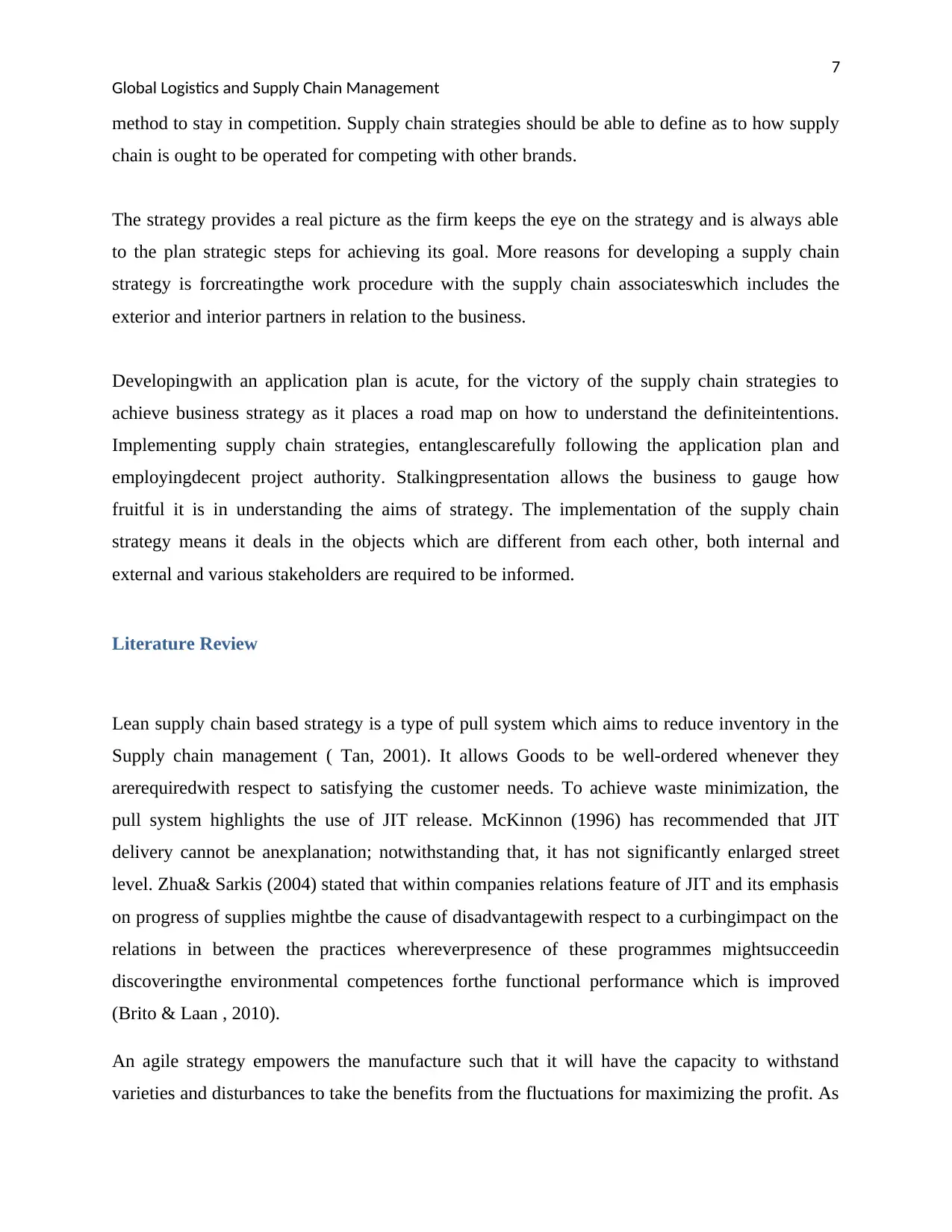
7
Global Logistics and Supply Chain Management
method to stay in competition. Supply chain strategies should be able to define as to how supply
chain is ought to be operated for competing with other brands.
The strategy provides a real picture as the firm keeps the eye on the strategy and is always able
to the plan strategic steps for achieving its goal. More reasons for developing a supply chain
strategy is forcreatingthe work procedure with the supply chain associateswhich includes the
exterior and interior partners in relation to the business.
Developingwith an application plan is acute, for the victory of the supply chain strategies to
achieve business strategy as it places a road map on how to understand the definiteintentions.
Implementing supply chain strategies, entanglescarefully following the application plan and
employingdecent project authority. Stalkingpresentation allows the business to gauge how
fruitful it is in understanding the aims of strategy. The implementation of the supply chain
strategy means it deals in the objects which are different from each other, both internal and
external and various stakeholders are required to be informed.
Literature Review
Lean supply chain based strategy is a type of pull system which aims to reduce inventory in the
Supply chain management ( Tan, 2001). It allows Goods to be well-ordered whenever they
arerequiredwith respect to satisfying the customer needs. To achieve waste minimization, the
pull system highlights the use of JIT release. McKinnon (1996) has recommended that JIT
delivery cannot be anexplanation; notwithstanding that, it has not significantly enlarged street
level. Zhua& Sarkis (2004) stated that within companies relations feature of JIT and its emphasis
on progress of supplies mightbe the cause of disadvantagewith respect to a curbingimpact on the
relations in between the practices whereverpresence of these programmes mightsucceedin
discoveringthe environmental competences forthe functional performance which is improved
(Brito & Laan , 2010).
An agile strategy empowers the manufacture such that it will have the capacity to withstand
varieties and disturbances to take the benefits from the fluctuations for maximizing the profit. As
Global Logistics and Supply Chain Management
method to stay in competition. Supply chain strategies should be able to define as to how supply
chain is ought to be operated for competing with other brands.
The strategy provides a real picture as the firm keeps the eye on the strategy and is always able
to the plan strategic steps for achieving its goal. More reasons for developing a supply chain
strategy is forcreatingthe work procedure with the supply chain associateswhich includes the
exterior and interior partners in relation to the business.
Developingwith an application plan is acute, for the victory of the supply chain strategies to
achieve business strategy as it places a road map on how to understand the definiteintentions.
Implementing supply chain strategies, entanglescarefully following the application plan and
employingdecent project authority. Stalkingpresentation allows the business to gauge how
fruitful it is in understanding the aims of strategy. The implementation of the supply chain
strategy means it deals in the objects which are different from each other, both internal and
external and various stakeholders are required to be informed.
Literature Review
Lean supply chain based strategy is a type of pull system which aims to reduce inventory in the
Supply chain management ( Tan, 2001). It allows Goods to be well-ordered whenever they
arerequiredwith respect to satisfying the customer needs. To achieve waste minimization, the
pull system highlights the use of JIT release. McKinnon (1996) has recommended that JIT
delivery cannot be anexplanation; notwithstanding that, it has not significantly enlarged street
level. Zhua& Sarkis (2004) stated that within companies relations feature of JIT and its emphasis
on progress of supplies mightbe the cause of disadvantagewith respect to a curbingimpact on the
relations in between the practices whereverpresence of these programmes mightsucceedin
discoveringthe environmental competences forthe functional performance which is improved
(Brito & Laan , 2010).
An agile strategy empowers the manufacture such that it will have the capacity to withstand
varieties and disturbances to take the benefits from the fluctuations for maximizing the profit. As
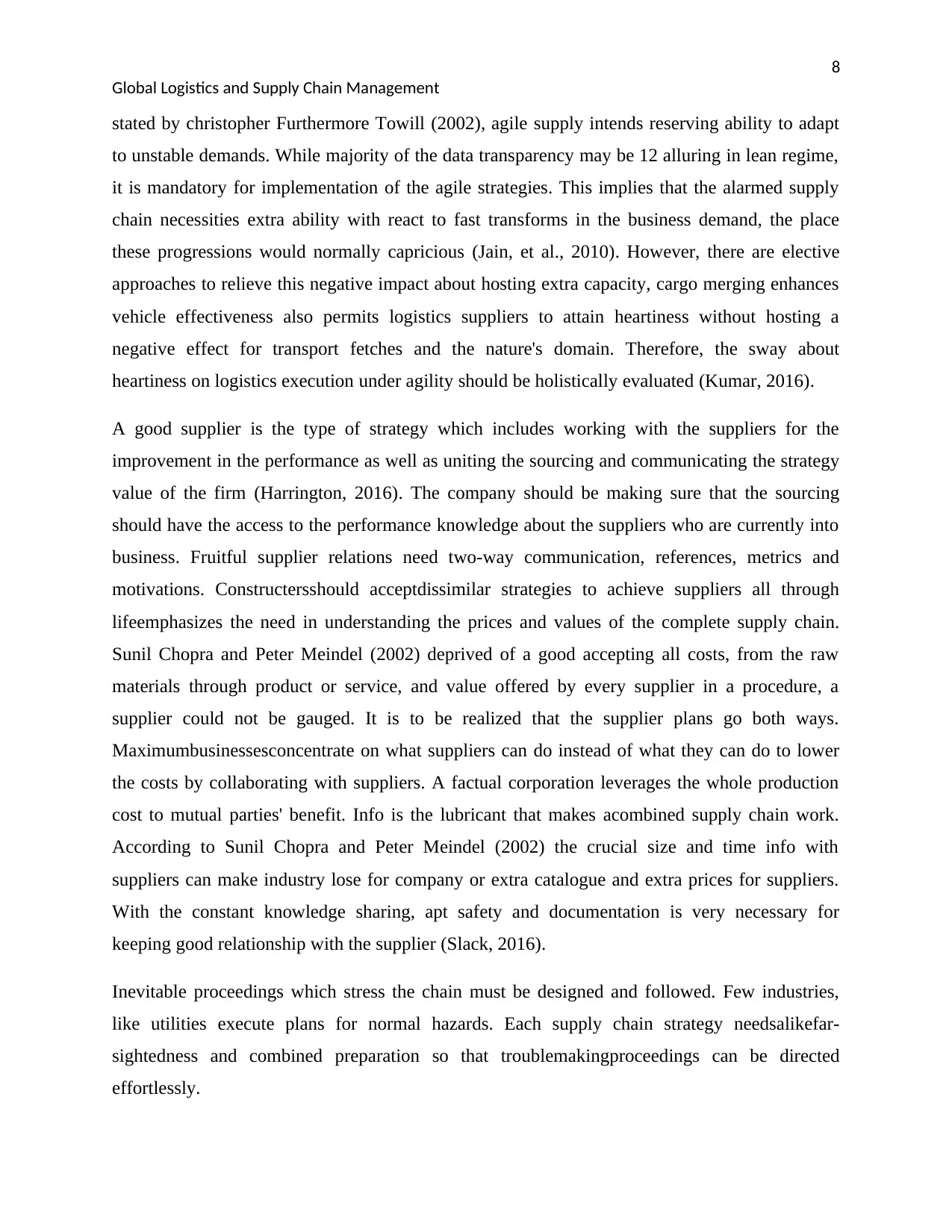
8
Global Logistics and Supply Chain Management
stated by christopher Furthermore Towill (2002), agile supply intends reserving ability to adapt
to unstable demands. While majority of the data transparency may be 12 alluring in lean regime,
it is mandatory for implementation of the agile strategies. This implies that the alarmed supply
chain necessities extra ability with react to fast transforms in the business demand, the place
these progressions would normally capricious (Jain, et al., 2010). However, there are elective
approaches to relieve this negative impact about hosting extra capacity, cargo merging enhances
vehicle effectiveness also permits logistics suppliers to attain heartiness without hosting a
negative effect for transport fetches and the nature's domain. Therefore, the sway about
heartiness on logistics execution under agility should be holistically evaluated (Kumar, 2016).
A good supplier is the type of strategy which includes working with the suppliers for the
improvement in the performance as well as uniting the sourcing and communicating the strategy
value of the firm (Harrington, 2016). The company should be making sure that the sourcing
should have the access to the performance knowledge about the suppliers who are currently into
business. Fruitful supplier relations need two-way communication, references, metrics and
motivations. Constructersshould acceptdissimilar strategies to achieve suppliers all through
lifeemphasizes the need in understanding the prices and values of the complete supply chain.
Sunil Chopra and Peter Meindel (2002) deprived of a good accepting all costs, from the raw
materials through product or service, and value offered by every supplier in a procedure, a
supplier could not be gauged. It is to be realized that the supplier plans go both ways.
Maximumbusinessesconcentrate on what suppliers can do instead of what they can do to lower
the costs by collaborating with suppliers. A factual corporation leverages the whole production
cost to mutual parties' benefit. Info is the lubricant that makes acombined supply chain work.
According to Sunil Chopra and Peter Meindel (2002) the crucial size and time info with
suppliers can make industry lose for company or extra catalogue and extra prices for suppliers.
With the constant knowledge sharing, apt safety and documentation is very necessary for
keeping good relationship with the supplier (Slack, 2016).
Inevitable proceedings which stress the chain must be designed and followed. Few industries,
like utilities execute plans for normal hazards. Each supply chain strategy needsalikefar-
sightedness and combined preparation so that troublemakingproceedings can be directed
effortlessly.
Global Logistics and Supply Chain Management
stated by christopher Furthermore Towill (2002), agile supply intends reserving ability to adapt
to unstable demands. While majority of the data transparency may be 12 alluring in lean regime,
it is mandatory for implementation of the agile strategies. This implies that the alarmed supply
chain necessities extra ability with react to fast transforms in the business demand, the place
these progressions would normally capricious (Jain, et al., 2010). However, there are elective
approaches to relieve this negative impact about hosting extra capacity, cargo merging enhances
vehicle effectiveness also permits logistics suppliers to attain heartiness without hosting a
negative effect for transport fetches and the nature's domain. Therefore, the sway about
heartiness on logistics execution under agility should be holistically evaluated (Kumar, 2016).
A good supplier is the type of strategy which includes working with the suppliers for the
improvement in the performance as well as uniting the sourcing and communicating the strategy
value of the firm (Harrington, 2016). The company should be making sure that the sourcing
should have the access to the performance knowledge about the suppliers who are currently into
business. Fruitful supplier relations need two-way communication, references, metrics and
motivations. Constructersshould acceptdissimilar strategies to achieve suppliers all through
lifeemphasizes the need in understanding the prices and values of the complete supply chain.
Sunil Chopra and Peter Meindel (2002) deprived of a good accepting all costs, from the raw
materials through product or service, and value offered by every supplier in a procedure, a
supplier could not be gauged. It is to be realized that the supplier plans go both ways.
Maximumbusinessesconcentrate on what suppliers can do instead of what they can do to lower
the costs by collaborating with suppliers. A factual corporation leverages the whole production
cost to mutual parties' benefit. Info is the lubricant that makes acombined supply chain work.
According to Sunil Chopra and Peter Meindel (2002) the crucial size and time info with
suppliers can make industry lose for company or extra catalogue and extra prices for suppliers.
With the constant knowledge sharing, apt safety and documentation is very necessary for
keeping good relationship with the supplier (Slack, 2016).
Inevitable proceedings which stress the chain must be designed and followed. Few industries,
like utilities execute plans for normal hazards. Each supply chain strategy needsalikefar-
sightedness and combined preparation so that troublemakingproceedings can be directed
effortlessly.
⊘ This is a preview!⊘
Do you want full access?
Subscribe today to unlock all pages.

Trusted by 1+ million students worldwide
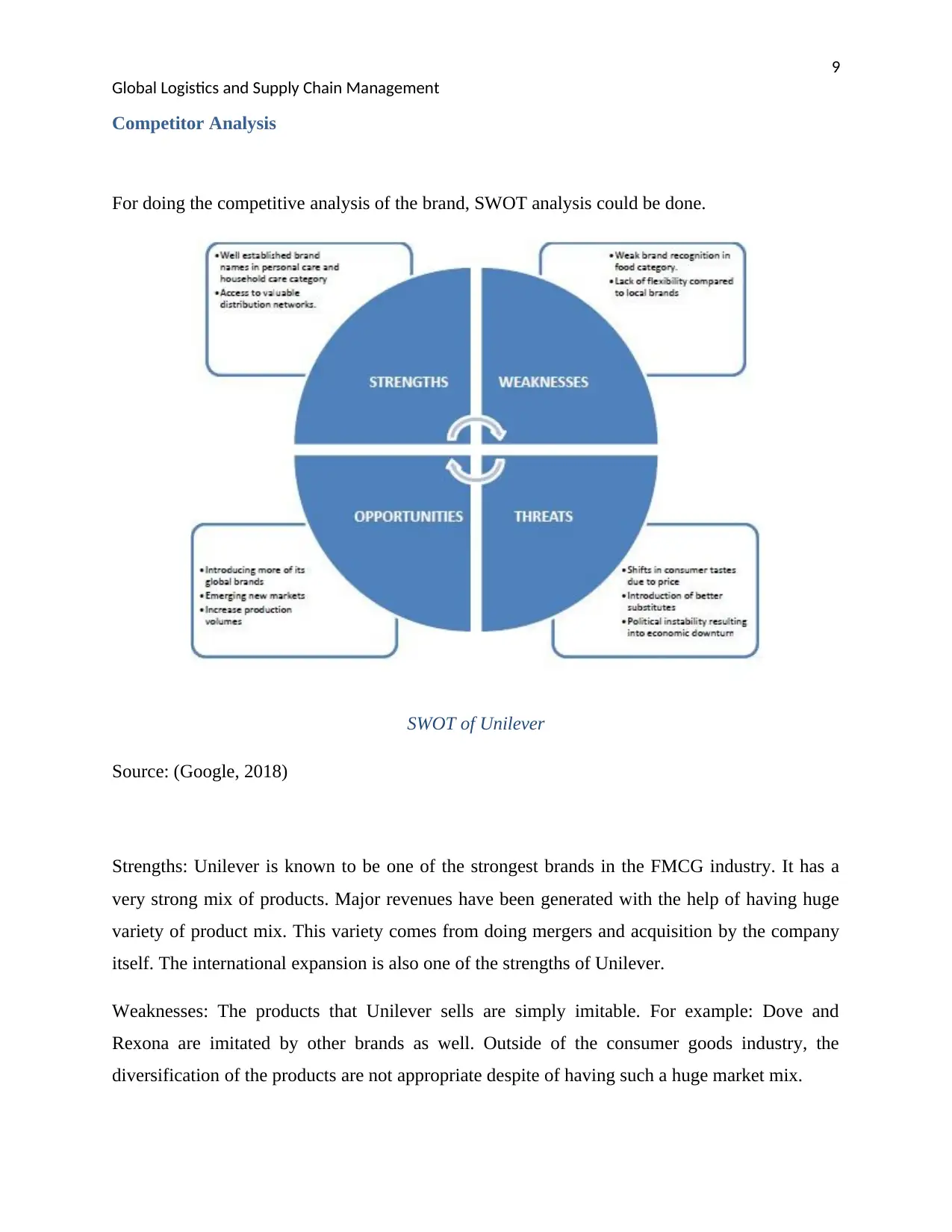
9
Global Logistics and Supply Chain Management
Competitor Analysis
For doing the competitive analysis of the brand, SWOT analysis could be done.
SWOT of Unilever
Source: (Google, 2018)
Strengths: Unilever is known to be one of the strongest brands in the FMCG industry. It has a
very strong mix of products. Major revenues have been generated with the help of having huge
variety of product mix. This variety comes from doing mergers and acquisition by the company
itself. The international expansion is also one of the strengths of Unilever.
Weaknesses: The products that Unilever sells are simply imitable. For example: Dove and
Rexona are imitated by other brands as well. Outside of the consumer goods industry, the
diversification of the products are not appropriate despite of having such a huge market mix.
Global Logistics and Supply Chain Management
Competitor Analysis
For doing the competitive analysis of the brand, SWOT analysis could be done.
SWOT of Unilever
Source: (Google, 2018)
Strengths: Unilever is known to be one of the strongest brands in the FMCG industry. It has a
very strong mix of products. Major revenues have been generated with the help of having huge
variety of product mix. This variety comes from doing mergers and acquisition by the company
itself. The international expansion is also one of the strengths of Unilever.
Weaknesses: The products that Unilever sells are simply imitable. For example: Dove and
Rexona are imitated by other brands as well. Outside of the consumer goods industry, the
diversification of the products are not appropriate despite of having such a huge market mix.
Paraphrase This Document
Need a fresh take? Get an instant paraphrase of this document with our AI Paraphraser
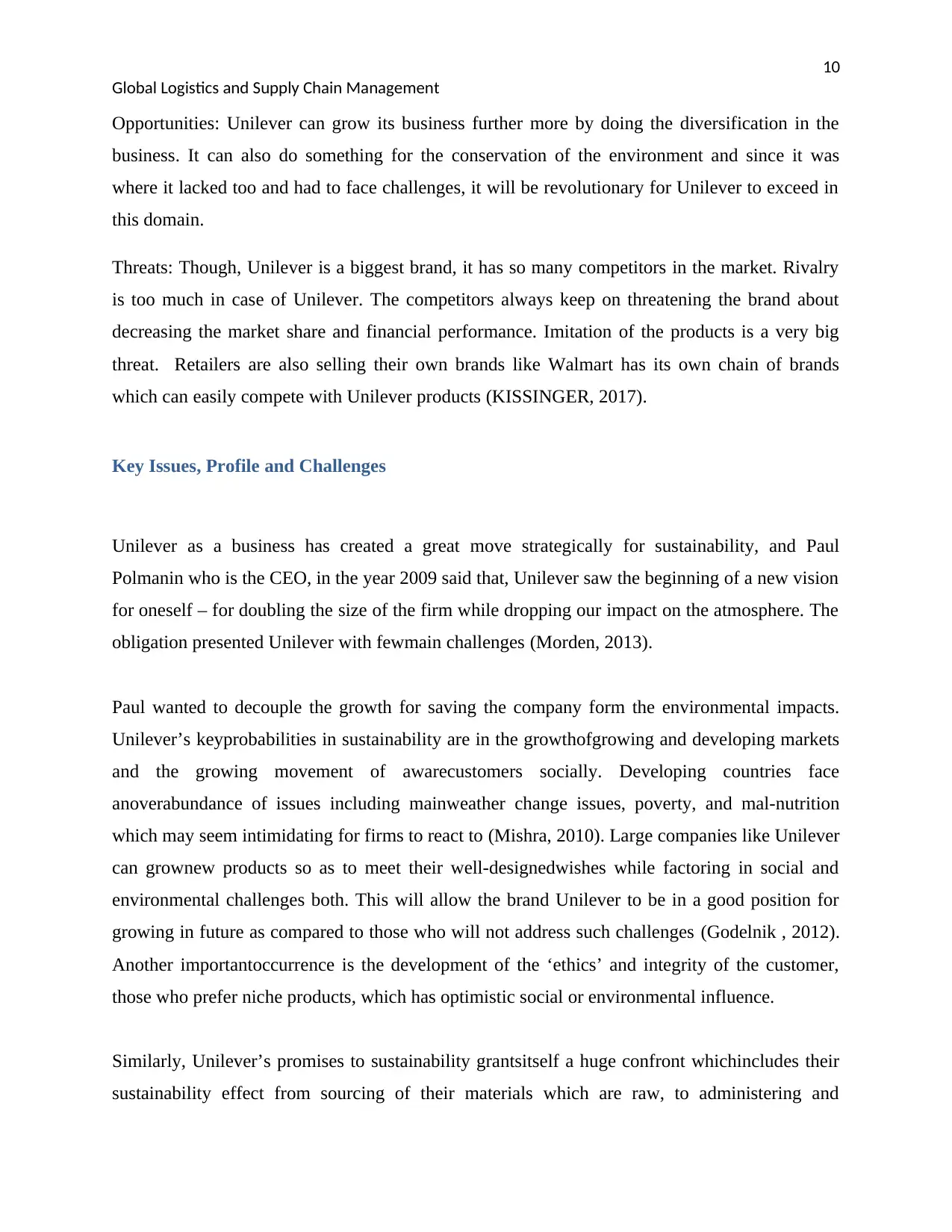
10
Global Logistics and Supply Chain Management
Opportunities: Unilever can grow its business further more by doing the diversification in the
business. It can also do something for the conservation of the environment and since it was
where it lacked too and had to face challenges, it will be revolutionary for Unilever to exceed in
this domain.
Threats: Though, Unilever is a biggest brand, it has so many competitors in the market. Rivalry
is too much in case of Unilever. The competitors always keep on threatening the brand about
decreasing the market share and financial performance. Imitation of the products is a very big
threat. Retailers are also selling their own brands like Walmart has its own chain of brands
which can easily compete with Unilever products (KISSINGER, 2017).
Key Issues, Profile and Challenges
Unilever as a business has created a great move strategically for sustainability, and Paul
Polmanin who is the CEO, in the year 2009 said that, Unilever saw the beginning of a new vision
for oneself – for doubling the size of the firm while dropping our impact on the atmosphere. The
obligation presented Unilever with fewmain challenges (Morden, 2013).
Paul wanted to decouple the growth for saving the company form the environmental impacts.
Unilever’s keyprobabilities in sustainability are in the growthofgrowing and developing markets
and the growing movement of awarecustomers socially. Developing countries face
anoverabundance of issues including mainweather change issues, poverty, and mal-nutrition
which may seem intimidating for firms to react to (Mishra, 2010). Large companies like Unilever
can grownew products so as to meet their well-designedwishes while factoring in social and
environmental challenges both. This will allow the brand Unilever to be in a good position for
growing in future as compared to those who will not address such challenges (Godelnik , 2012).
Another importantoccurrence is the development of the ‘ethics’ and integrity of the customer,
those who prefer niche products, which has optimistic social or environmental influence.
Similarly, Unilever’s promises to sustainability grantsitself a huge confront whichincludes their
sustainability effect from sourcing of their materials which are raw, to administering and
Global Logistics and Supply Chain Management
Opportunities: Unilever can grow its business further more by doing the diversification in the
business. It can also do something for the conservation of the environment and since it was
where it lacked too and had to face challenges, it will be revolutionary for Unilever to exceed in
this domain.
Threats: Though, Unilever is a biggest brand, it has so many competitors in the market. Rivalry
is too much in case of Unilever. The competitors always keep on threatening the brand about
decreasing the market share and financial performance. Imitation of the products is a very big
threat. Retailers are also selling their own brands like Walmart has its own chain of brands
which can easily compete with Unilever products (KISSINGER, 2017).
Key Issues, Profile and Challenges
Unilever as a business has created a great move strategically for sustainability, and Paul
Polmanin who is the CEO, in the year 2009 said that, Unilever saw the beginning of a new vision
for oneself – for doubling the size of the firm while dropping our impact on the atmosphere. The
obligation presented Unilever with fewmain challenges (Morden, 2013).
Paul wanted to decouple the growth for saving the company form the environmental impacts.
Unilever’s keyprobabilities in sustainability are in the growthofgrowing and developing markets
and the growing movement of awarecustomers socially. Developing countries face
anoverabundance of issues including mainweather change issues, poverty, and mal-nutrition
which may seem intimidating for firms to react to (Mishra, 2010). Large companies like Unilever
can grownew products so as to meet their well-designedwishes while factoring in social and
environmental challenges both. This will allow the brand Unilever to be in a good position for
growing in future as compared to those who will not address such challenges (Godelnik , 2012).
Another importantoccurrence is the development of the ‘ethics’ and integrity of the customer,
those who prefer niche products, which has optimistic social or environmental influence.
Similarly, Unilever’s promises to sustainability grantsitself a huge confront whichincludes their
sustainability effect from sourcing of their materials which are raw, to administering and
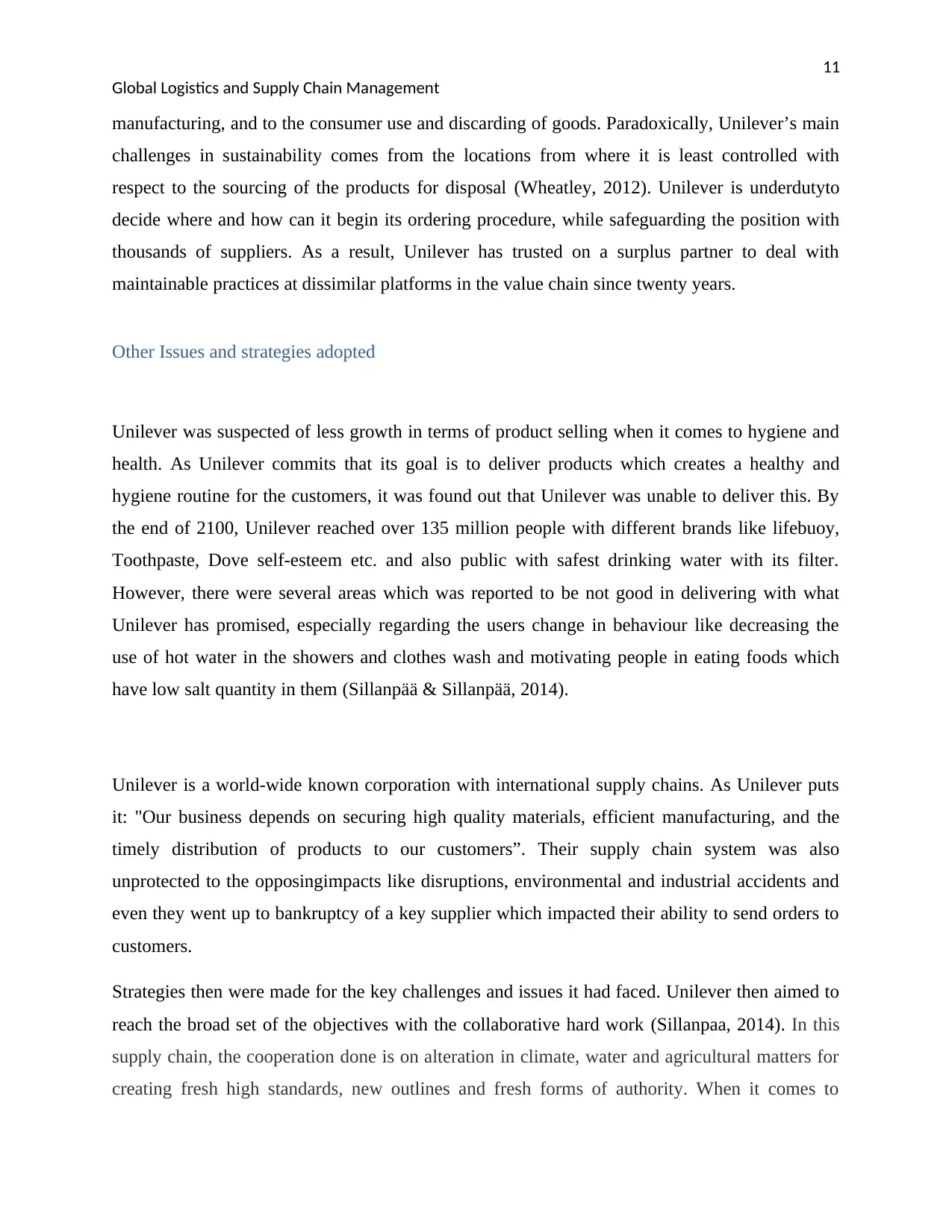
11
Global Logistics and Supply Chain Management
manufacturing, and to the consumer use and discarding of goods. Paradoxically, Unilever’s main
challenges in sustainability comes from the locations from where it is least controlled with
respect to the sourcing of the products for disposal (Wheatley, 2012). Unilever is underdutyto
decide where and how can it begin its ordering procedure, while safeguarding the position with
thousands of suppliers. As a result, Unilever has trusted on a surplus partner to deal with
maintainable practices at dissimilar platforms in the value chain since twenty years.
Other Issues and strategies adopted
Unilever was suspected of less growth in terms of product selling when it comes to hygiene and
health. As Unilever commits that its goal is to deliver products which creates a healthy and
hygiene routine for the customers, it was found out that Unilever was unable to deliver this. By
the end of 2100, Unilever reached over 135 million people with different brands like lifebuoy,
Toothpaste, Dove self-esteem etc. and also public with safest drinking water with its filter.
However, there were several areas which was reported to be not good in delivering with what
Unilever has promised, especially regarding the users change in behaviour like decreasing the
use of hot water in the showers and clothes wash and motivating people in eating foods which
have low salt quantity in them (Sillanpää & Sillanpää, 2014).
Unilever is a world-wide known corporation with international supply chains. As Unilever puts
it: "Our business depends on securing high quality materials, efficient manufacturing, and the
timely distribution of products to our customers”. Their supply chain system was also
unprotected to the opposingimpacts like disruptions, environmental and industrial accidents and
even they went up to bankruptcy of a key supplier which impacted their ability to send orders to
customers.
Strategies then were made for the key challenges and issues it had faced. Unilever then aimed to
reach the broad set of the objectives with the collaborative hard work (Sillanpaa, 2014). In this
supply chain, the cooperation done is on alteration in climate, water and agricultural matters for
creating fresh high standards, new outlines and fresh forms of authority. When it comes to
Global Logistics and Supply Chain Management
manufacturing, and to the consumer use and discarding of goods. Paradoxically, Unilever’s main
challenges in sustainability comes from the locations from where it is least controlled with
respect to the sourcing of the products for disposal (Wheatley, 2012). Unilever is underdutyto
decide where and how can it begin its ordering procedure, while safeguarding the position with
thousands of suppliers. As a result, Unilever has trusted on a surplus partner to deal with
maintainable practices at dissimilar platforms in the value chain since twenty years.
Other Issues and strategies adopted
Unilever was suspected of less growth in terms of product selling when it comes to hygiene and
health. As Unilever commits that its goal is to deliver products which creates a healthy and
hygiene routine for the customers, it was found out that Unilever was unable to deliver this. By
the end of 2100, Unilever reached over 135 million people with different brands like lifebuoy,
Toothpaste, Dove self-esteem etc. and also public with safest drinking water with its filter.
However, there were several areas which was reported to be not good in delivering with what
Unilever has promised, especially regarding the users change in behaviour like decreasing the
use of hot water in the showers and clothes wash and motivating people in eating foods which
have low salt quantity in them (Sillanpää & Sillanpää, 2014).
Unilever is a world-wide known corporation with international supply chains. As Unilever puts
it: "Our business depends on securing high quality materials, efficient manufacturing, and the
timely distribution of products to our customers”. Their supply chain system was also
unprotected to the opposingimpacts like disruptions, environmental and industrial accidents and
even they went up to bankruptcy of a key supplier which impacted their ability to send orders to
customers.
Strategies then were made for the key challenges and issues it had faced. Unilever then aimed to
reach the broad set of the objectives with the collaborative hard work (Sillanpaa, 2014). In this
supply chain, the cooperation done is on alteration in climate, water and agricultural matters for
creating fresh high standards, new outlines and fresh forms of authority. When it comes to
⊘ This is a preview!⊘
Do you want full access?
Subscribe today to unlock all pages.

Trusted by 1+ million students worldwide
1 out of 17
Related Documents
Your All-in-One AI-Powered Toolkit for Academic Success.
+13062052269
info@desklib.com
Available 24*7 on WhatsApp / Email
![[object Object]](/_next/static/media/star-bottom.7253800d.svg)
Unlock your academic potential
Copyright © 2020–2025 A2Z Services. All Rights Reserved. Developed and managed by ZUCOL.




